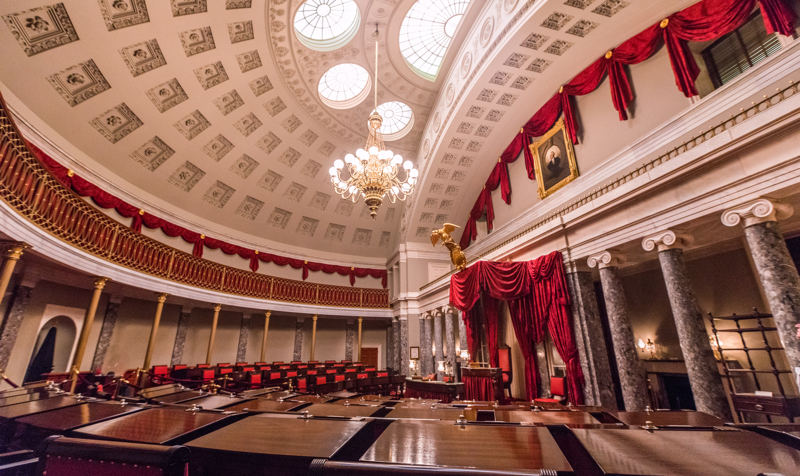
The Supreme Court’s recent Weyerhaeuser decision will add to the administrative costs of protecting endangered species.
In Weyerhaeuser v. US Fish and Wildlife Service, a unanimous Supreme Court, with Justice Gorsuch not participating, indicated that it is not inclined to defer to agency expertise. Judicial power dominates this Court’s approach to administrative law, not just in the context of Chevron deference, and not just within the conservative wing. The Weyerhaeuser decision is likely to complicate future implementation of at least the Endangered Species Act (ESA) and may further entrench the power of cost-benefit analysis in other areas of regulation too.
The case arose out of a perceived conflict between private property rights and conservation of the uncharismatic, but highly endangered, dusky gopher frog. The ESA requires that the Fish and Wildlife Service designate “critical habitat” when it lists a species. Critical habitat can include areas within and outside where the species currently resides, but the two are treated somewhat differently. Occupied areas are included if they have “physical or biological features essential to” conservation of the species and may require special management or protection. Areas not currently occupied by the species are included if the Service determines that they are “essential for the conservation of the species.”
In identifying critical habitat, the Service must “take into consideration” the economic and other impacts of designation. It “may exclude any area from critical habitat if … the benefits of such exclusion outweigh” those of designation, unless exclusion would cause the extinction of the species.
Critical habitat has limited direct impact on private land. Federal agencies must consult with the Service before taking or approving actions that may affect critical habitat and must avoid destruction or adverse modification of designated critical habitat. Absent a federal permitting nexus, however, landowners remain free to develop as they wish. Even with such a federal nexus, consultation almost never halts development plans. Nonetheless, designation is fiercely resisted, and it can reduce a property’s market value.
The Service did not initially designate any critical habitat for the dusky gopher frog. Faced with a lawsuit, it proposed to designate less than 2,000 acres, all within a small area of Mississippi. Scientific reviewers objected that a localized drought or other environmental crisis could wipe out the entire proposed critical habitat. The Service responded by adding a 1,500-acre complex of ephemeral ponds, called “Unit 1,” some distance away, in southeastern Louisiana. Unit 1 is the last place dusky gopher frogs were seen in Louisiana, in 1965, but none currently live there.
Weyerhaeuser, which owns part of Unit 1 and leases the rest for timber production, claimed that Unit 1 could not be designated because it cannot support a frog population in its current condition. Alternatively, Weyerhaeuser contended that the Service should have excluded Unit 1 because the economic costs of designation greatly exceeded the conservation benefits. The U.S. District Court for the Eastern District of Louisiana and the U.S. Court of Appeals for the Fifth Circuit rejected both arguments, deferring to the Service’s identification of critical habitat.
The Supreme Court disagreed. It ruled that critical habitat must qualify as “habitat,” and also that scan be reviewed for abuse of discretion. The Court’s opinion is narrow, and the actual outcome of the dispute remains to be determined. Still, the decision demonstrates substantial resistance, even among the most agency-friendly justices, to deference.
Identification of “critical habitat” must begin with the statutory definition, which draws a distinction between occupied and unoccupied habitat. The former must have specific physical or biological features that are essential for conservation of the species and may require special management efforts, known as “primary constituent elements.” The latter need only be essential for conservation of the species.
The Service identified three primary constituent elements of gopher frog habitat: (1) ephemeral breeding ponds that hold water long enough, have the right water quality and vegetation to support breeding, and lack predatory fish; (2) upland forested areas with open canopies, abundant ground cover, and underground burrows in which the adult frogs can take refuge; and (3) areas connecting the two with sufficient cover to allow the frogs to move between them. The occupied areas designated as critical habitat contained all three of the primary constituent elements.
Unit 1, by contrast, contained only the ephemeral breeding ponds. The Service read the ESA to allow designation of unoccupied habitat if, but only if, those areas would be needed for the species to recover to the point of delisting. The Service believed that the presence or absence of primary constituent elements was irrelevant. It designated Unit 1 because the frog could not be secure against extinction without expansion of its geographic range, and Unit 1 contained high quality ephemeral ponds, the most difficult aspect of the frog’s habitat to restore or create.
In the lower courts, the Service benefited from judicial deference both to its interpretation of the statutory requirements for designating unoccupied habitat and to its understanding of the facts. The District Court, while noting its discomfort with the Service’s “intrusive” action and “insensitivity to private property,” nonetheless concluded that it must defer both to the Service’s determination of what it means for habitat to be “essential,” and to its factual determination that the statute’s requirements were satisfied. The Fifth Circuit agreed that both Chevron deference to the legal interpretation and Baltimore Gas deference to the agency’s scientific determination that Unit 1 provided critical habitat were warranted.
The Supreme Court offered no deference. It concluded that critical habitat must be a subset of some more nebulous concept of “habitat.” That conclusion might be unproblematic, were it not combined with a highly restrictive view of the meaning of “habitat,” a term the Court should have acknowledged is neither defined in the statute nor unambiguous. The Court did leave to the lower courts the evaluation of whether habitat could include “areas that, like Unit 1, would require some degree of modification to support a sustainable population,” and whether the frog could survive in Unit 1. The lower courts remain technically free to decide that deference is due on both those questions.
The decision discourages such deference, however. The Court refused to directly endorse deference to the Service’s definition of habitat. It also refused to engage with arguments made by the Service, by amici dusky gopher frog experts, and by amici scientists that the term “habitat” covers a spectrum of areas, from those optimal for the species to those only marginally suitable. It would be easy for the lower courts, which are already queasy about the possible effect of designation on private landowners, to read the decision as limiting unoccupied “habitat” to only the most optimal areas. Furthermore, by equating “habitat” with current “habitability,” the Court seems to have, perhaps unintentionally, blocked protection of areas which provide ephemeral or shifting habitat, or which feed essential inputs into areas where a protected species lives.
The Court’s treatment of the second issue presented in Weyerhaeuser, whether the Service’s decision not to exclude Unit 1 from critical habitat was judicially reviewable, reinforces its unwillingness to defer to the Service. Some of the fault must rest with Congress; the statute is unquestionably confusing. But the Court’s opinion, by overemphasizing the role of cost-benefit analysis, will impose added costs on the Service for little purpose.
The critical habitat provision contains two separate but related elements. The first requires that the Service consider the economic, national security, and other impacts of critical habitat designation. The second authorizes, but does not require, the Service to exclude areas for which it finds that the benefits of exclusion outweigh the benefits of inclusion. By conflating the two, the Court reached the conclusion that the entirely discretionary agency decision not to exclude an area from critical habitat could be judicially overridden.
The Service did conduct an economic analysis, which concluded that designating Unit 1 as critical habitat could impose costs ranging anywhere from $0 to $33.9 million. The extreme uncertainty reflected the difficulty of forecasting future land use decisions, identifying any federal jurisdictional wetlands on the property and predicting what conditions might be imposed on a federal permit. Based on that analysis, the Service tersely explained that it did not see those costs as disproportionate to the biological benefits, and therefore it would not exclude Unit 1.
The Court held that the Fifth Circuit must consider whether the cost-benefit analysis “was flawed in a way that rendered the resulting decision not to exclude Unit 1 arbitrary, capricious, or an abuse of discretion.” Rather than add anything useful to the analysis already conducted, that holding invites lower courts to apply strict cost-benefit analysis to questions ill-suited to such treatment.
Here, the District Court had found that the economic analysis, with its wide sideboards, fulfilled the Service’s statutory obligations. The Service, prodded by its external scientific reviewers and as required by the ESA, had found Unit 1 to be essential to conservation of the species. The Supreme Court itself, in its first ESA decision, TVA v. Hill, noted that Congress in passing the ESA described the value of endangered species as “incalculable.” It cannot be outside the Service’s discretion to refuse to exclude an area essential to the recovery of a species of incalculable value based on costs that might be high but might amount to nothing at all. There is simply no point to judicial review in this context.
The Court would have done better to deny review in Weyerhaeuser. Its decision will add unnecessary administrative costs, as the Service elaborates on its explanations and lower courts review more intrusively. It will encourage disgruntled landowners to flyspeck economic reviews. But, if the Service and the lower courts do their jobs faithfully, it will in the end not alter many conservation decisions.
This essay is part of a series, entitled The Supreme Court’s 2018–2019 Regulatory Term.




